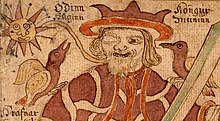Animal language
The most diverse complex forms of communication of all animal species are collectively referred to as animal language .
This communication can take place through acoustic , chemical or visual signals, in some animal species - such as the electric eel - but also through electrical signals ( bioelectricity ). Communication via gestures (for example with monkeys ) and ritualized forms such as the dance language of the honeybees are known. In a broader sense, behavior patterns that are strongly related to the situation, such as courtship behavior, are sometimes referred to as animal language .
The elementary components of their communication behavior are innate in all animal species and presumably developed independently of one another in many animal groups, but can often be modified and expanded through learning. Dolphins , primates and parrots are generally known to be particularly communicative and at the same time extremely capable of learning in this area , as are all domestic animals such as dogs and rabbits that live in groups in nature .
Primates
It is unclear, however, which connections exist between the communication systems of the primates living today and the ability of humans to speak, since several communication systems may have developed independently of one another in the primates, which differ fundamentally in their systematic approaches.
The warning calls of the howler monkeys, which are diversified according to the type of danger (which thus have a primitive mental lexicon ), are particularly important here . The language skills of chimpanzees seem to be particularly close to humans , as the studies by Roger Fouts on their language learning ability have shown.
History of science
Especially in fables and fairy tales , but occasionally also in other literary texts, the animals speak the language of humans (or humans that of animals: see Dr. Dolittle ) and then usually behave like humans. This very old transfer of human peculiarities to animals has for a long time blocked even naturalists from seeing that many animal species have highly complex communication systems that can rightly be described as independent forms of a language . Therefore, the view persisted into the 20th century that the ability to speak is an exclusively human quality. Only the semantic peculiarities of the dance language of honey bees, deciphered by Karl von Frisch , led to a rethink.
See also
- Appeasement signals in dogs
- Bioacoustics
- Communication of the cat
- Voice feeling
- Birdsong , whalesong
- Zoo semiotics
- The expression of the emotions in humans and animals
Web links
- Study: Songbirds can learn basic grammar. ( Memento of March 13, 2008 in the Internet Archive )
